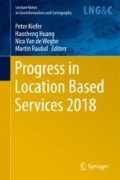Abstract
Conflating multiple geospatial data sets into a single dataset is challenging. It requires resolving spatial and aspatial attribute conflicts between source data sets so the best value can be retained and duplicate features removed. Domain experts are able to conflate data using manual comparison techniques, but the task it is labour intensive when dealing with large data sets. This paper demonstrates how semantic technologies can be used to automate the geospatial data conflation process by showcasing how three Points of Interest (POI) data sets can be conflated into a single data set. First, an ontology is generated based on a multipurpose POI data model. Then the disparate source formats are transformed into the RDF format and linked to the designed POI Ontology during the conversion. When doing format transformations, SWRL rules take advantage of the relationships specified in the ontology to convert attribute data from different schemas to the same attribute granularity level. Finally, a chain of SWRL rules are used to replicate human logic and reasoning in the filtering process to find matched POIs and in the reasoning process to automatically make decisions where there is a conflict between attribute values. A conflated POI dataset reduces duplicates and improves the accuracy and confidence of POIs thus increasing the ability of emergency services agencies to respond quickly and correctly to emergency callouts where times are critical.
Access this chapter
Tax calculation will be finalised at checkout
Purchases are for personal use only
Notes
- 1.
- 2.
- 3.
- 4.
A wide-ranging definition of a Point of Interest (POI) is any feature or service that people wish to visit or know the location of, and is of value to the community (WALIS).
- 5.
The OGC GeoSPARQL standard supports representing and querying geospatial data on the Semantic Web. http://www.opengeospatial.org/standards/geosparql.
- 6.
Protégé is a free, open-source platform that provides a suite of tools to construct domain models and knowledge-based applications with ontologies.
- 7.
Pellet is an open-source Java based OWL 2 reasoner https://www.w3.org/2001/sw/wiki/Pellet.
- 8.
https://crcsi.amristar.com/automatedconflation; username: crcsi; password: l@ndg@te.
References
Bishr Y (1998) Overcoming the semantic and other barriers to GIS interoperability. Int J Geogr Inf Sci 12(4):299–314
Chen C-C et al (2004) Automatically and accurately conflating orthoimagery and street maps. In: Proceedings of the 12th annual ACM international workshop on Geographic information systems. ACM
Chen C-C et al (2006) Automatically conflating road vector data with orthoimagery. GeoInformatica 10(4):495–530
Chen C-C et al (2008) Automatically and accurately conflating raster maps with orthoimagery. GeoInformatica 12(3):377–410
Dongcai HE (2013) A study on theory and method of spatial vector data conflation. Res J Appl Sci Eng Technol 5(2):563–567
Duckham M et al (2017) Towards a spatial knowledge infrastructure Australia and New Zealand CRC for spatial information
Flowerdew R (1991) Spatial data integration
Fonseca F et al (2002) Using ontologies for integrated geographic information systems. Trans GIS 6(3):231–257
Giannopoulos G et al (2015) FAGI-gis: a tool for fusing geospatial RDF data. In: The semantic web: ESWC 2015 satellite events: ESWC 2015 satellite events, Portorož, Slovenia, May 31–June 4, 2015. Springer International Publishing, pp 51–57
Janowicz K et al (2010) Semantic enablement for spatial data infrastructures. Trans GIS 14(2):111–129
Kang H (2001) Spatial data integration: a case study of map conflation with census bureau and local government data. http://www.cobblestoneconcepts.com/ucgis2summer/kang/kang_main.htm
Lutz M et al (2009) Overcoming semantic heterogeneity in spatial data infrastructures. Comput Geosci 35(4):739–752
Lynch MP, Saalfeld AJ (1985) Conflation: automated map compilation—a video game approach. Auto-Carto 7, Washington, DC, USA
Parekh V et al (2004) Ontology based semantic metadata for geoscience data. IKE
Patrick M, Sven S (2009) Data integration in the geospatial semantic web. J Cases Inf Technol (JCIT) 4(11):100–122
Saalfeld A (1988) Conflation automated map compilation. Int J Geogr Inf Syst 2(3):217–228
Sehgal V et al (2006) Entity resolution in geospatial data integration. In: Proceedings of the 14th annual ACM international symposium on advances in geographic information systems. Arlington, Virginia, USA, ACM, pp 83–90
Szekely P et al (2011) Exploiting semantics of web services for geospatial data fusion. In: Proceedings of the 1st ACM SIGSPATIAL international workshop on spatial semantics and ontologies. ACM, Chicago, Illinois, pp 32–39
Uitermark H et al (1999) Ontology-based geographic data set integration. In: Böhlen M, Jensen C, Scholl M (eds) Spatio-temporal database management, vol 1678. Springer, Berlin, Heidelberg, pp 60–78
Walter V, Fritsch D (1999) Matching spatial data sets: a statistical approach. Int J Geogr Inf Sci 13(5):445–473
Wiegand N, García C (2007) A task-based ontology approach to automate geospatial data retrieval. Trans GIS 11(3):355–376
Wiemann S, Bernard L (2016) Spatial data fusion in spatial data infrastructures using linked data. Int J Geogr Inf Sci 30(4):613–636
Yu F et al (2016) Automatic geospatial data conflation using semantic web technologies. In: Proceedings of the Australasian computer science week multiconference, Canberra, Australia. ACM, pp 1–10
Zhang Y et al (2013) A semantic approach to retrieving, linking, and integrating heterogeneous geospatial data. In: Joint proceedings of the workshop on ai problems and approaches for intelligent environments and workshop on semantic cities, Beijing, China. ACM, pp 31–37
Acknowledgements
The work has been supported by the Cooperative Research Centre for Spatial Information, whose activities are funded by the Australian Commonwealth’s Cooperative Research Centre Program.
Author information
Authors and Affiliations
Corresponding author
Editor information
Editors and Affiliations
Rights and permissions
Copyright information
© 2018 Springer International Publishing AG
About this paper
Cite this paper
Yu, F., McMeekin, D.A., Arnold, L., West, G. (2018). Semantic Web Technologies Automate Geospatial Data Conflation: Conflating Points of Interest Data for Emergency Response Services. In: Kiefer, P., Huang, H., Van de Weghe, N., Raubal, M. (eds) Progress in Location Based Services 2018. LBS 2018. Lecture Notes in Geoinformation and Cartography. Springer, Cham. https://doi.org/10.1007/978-3-319-71470-7_6
Download citation
DOI: https://doi.org/10.1007/978-3-319-71470-7_6
Published:
Publisher Name: Springer, Cham
Print ISBN: 978-3-319-71469-1
Online ISBN: 978-3-319-71470-7
eBook Packages: Earth and Environmental ScienceEarth and Environmental Science (R0)

